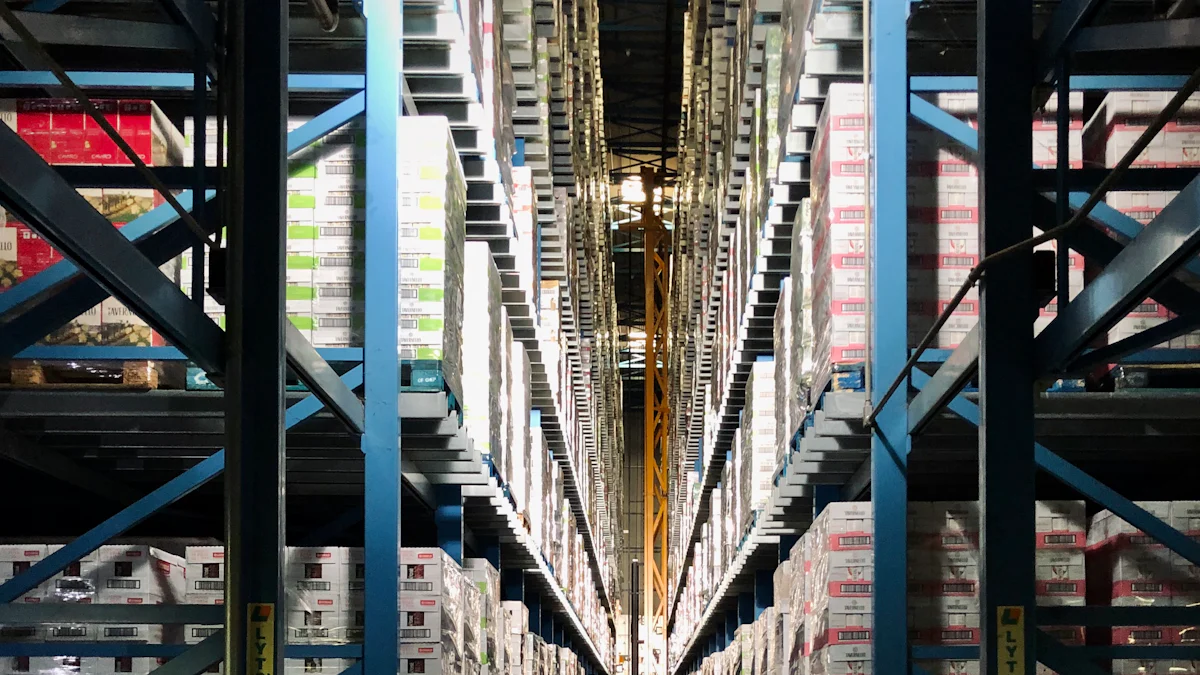Exploring Robotics Technology: Supply Chain Revolution

The significance of Overview of Robotics Technology Trends in Supply Chain Management is undeniable, with a transformative impact on the industry. Statistics reveal a substantial increase in robotics adoption rates, indicating a shift towards automation. For instance, there was a 7% rise in testing robots in warehouse locations from 2018 to 2019. Moreover, the global market for warehouse robotics is projected to [reach $22.4 billion](https://www.businesswire.com/news/home/20170315005774/en/Warehousing-Logistics-Robots-Report-2017-Global-1.9, null) by the end of 2021. These figures highlight the growing importance of integrating robotics into supply chain operations.
Overview of Robotics Technology Trends in Supply Chain Management
In the realm of supply chain management, the evolution of robotics has been a defining factor in reshaping operational dynamics. During the 2010s, the integration of AI-powered robotics and automation gained momentum, particularly in warehouses and distribution centers. This era witnessed the deployment of autonomous vehicles, drones, and robotic arms to streamline order fulfillment processes, minimize errors, and elevate overall supply chain productivity.
The journey of robotics and automation within the supply chain extends across various domains, from manufacturing facilities to warehousing setups and transportation networks. These technological advancements offer a myriad of benefits such as heightened efficiency levels, reduced error rates, and enhanced safety protocols. As companies embrace these innovations, they pave the way for a more streamlined and effective supply chain ecosystem.
Looking ahead, the future landscape of supply chain management is poised to witness a surge in autonomous robots, especially within operations involving lower-value tasks or those deemed potentially hazardous. Sectors like manufacturing, final assembly lines, and warehousing are already experiencing a robust presence of autonomous robots. These cutting-edge technologies not only enhance operational efficiency but also contribute significantly to cost reduction initiatives over the long term.
Among the notable advancements driving change in warehouse operations are Autonomous Mobile Robots (AMRs). The utilization of AMRs has emerged as a game-changer in revolutionizing traditional warehouse functions. By leveraging this technology, organizations can achieve unprecedented levels of efficiency while ensuring adaptability to evolving market demands.
Furthermore, the synergy between autonomous and collaborative robots has opened up new vistas for companies seeking sustained growth through enhanced productivity and stability. The integration of these innovative robotic solutions offers a host of advantages including cost optimization, improved labor efficiency, reduced error rates during operations like picking and sorting, thereby optimizing storage capabilities.
As businesses continue to capitalize on advancements in robotic automation technologies like AMRs deployed within warehouses for swift task execution with precision; it becomes evident that embracing these innovations is no longer an option but a necessity for staying competitive in today's dynamic market landscape.
Key Technologies in Robotics for Supply Chain

In the realm of supply chain management, Autonomous Mobile Robots (AMRs) have emerged as a pivotal technological advancement reshaping modern operations. These robots automate various tasks and processes within warehouses, enhancing efficiency, accuracy, and flexibility. AMRs utilize sophisticated sensor technology to navigate warehouse spaces seamlessly, delivering inventory with precision and speed. Unlike traditional systems, AMRs do not require fixed tracks between locations; instead, they interpret their surroundings through maps, computers, and onboard sensors.
Applications in Warehousing
AMRs excel in moving goods across warehouse facilities efficiently.
They integrate seamlessly with safety protocols to collaborate with human workers.
The dynamic performance improvements of AMRs are notable, providing real-time analysis of performance metrics.
Benefits and Challenges
When considering the benefits of Autonomous Mobile Robots (AMRs) in supply chain operations, it is evident that these innovative technologies offer substantial advantages:
Enhanced Efficiency: AMRs streamline inventory movement processes within warehouses, optimizing operational workflows.
Improved Accuracy: The precision and reliability of AMRs contribute to error reduction during order fulfillment tasks.
Flexibility: With their ability to adapt to changing environments, AMRs ensure operational agility in response to market fluctuations.
Despite the numerous benefits associated with Autonomous Mobile Robots (AMRs), there are challenges that organizations may encounter when implementing this technology:
Initial Investment Costs: The upfront expenses related to acquiring and deploying AMRs can be significant.
Maintenance Requirements: Ensuring the proper functioning of AMRs necessitates regular maintenance and technical support.
In parallel to the advancements in autonomous robotics, collaborative robots (Cobots) have also garnered attention for their unique capabilities within supply chain environments.
Working Alongside Humans
Collaborative robots (Cobots) are designed to work harmoniously alongside human employees.
Their adaptive nature allows them to support various workflows and product types simultaneously.
Safety and Efficiency
The integration of collaborative robots (Cobots) into supply chain operations prioritizes safety while enhancing overall efficiency:
Safety Protocols: Collaborative robots (Cobots) are equipped with advanced safety features to prevent accidents during human-robot interactions.
Operational Efficiency: By working collaboratively with human counterparts, Cobots optimize task completion times and improve overall productivity levels.
As organizations continue to embrace the transformative potential of robotics technologies like Autonomous Mobile Robots (AMRs) and Collaborative Robots (Cobots), they pave the way for enhanced operational excellence within their supply chains.
Impact of Robotics on Supply Chain Efficiency

Increased Speed and Accuracy
Picking and Packing
Enhancing supply chain efficiency through robotics technology is evident in the accelerated speed and heightened accuracy of picking and packing processes. Automated systems meticulously select items for orders, ensuring precise fulfillment with minimal errors. This streamlined approach significantly reduces processing times, expediting the delivery of goods to customers. The seamless coordination between robotic systems and warehouse operations optimizes the entire supply chain workflow, resulting in swift order processing and improved customer satisfaction.
Sorting and Distribution
The integration of robotics in sorting and distribution operations revolutionizes traditional methods by introducing advanced automation capabilities. Robots efficiently categorize products based on predefined criteria, facilitating rapid sorting processes within warehouses. By automating distribution tasks, organizations can achieve greater operational efficiency while minimizing errors associated with manual handling. The precision and consistency offered by robotic sorting systems enhance inventory management practices, enabling seamless order fulfillment and timely deliveries.
Cost Reduction and Labor Efficiency
Reduced Labor Costs
Robotics technology plays a pivotal role in reducing labor costs within supply chain operations by automating repetitive tasks that would otherwise require extensive human intervention. By leveraging automated solutions for routine activities such as inventory tracking, restocking shelves, and order processing, companies can optimize resource allocation and minimize labor expenses. The implementation of robotic systems not only streamlines operational workflows but also mitigates the need for additional human workforce in labor-intensive tasks.
Improved Operational Efficiency
The incorporation of robotics in supply chain management leads to enhanced operational efficiency through optimized task execution and resource utilization. Automated systems operate with precision and consistency, contributing to error reduction rates during various stages of the supply chain process. By streamlining workflows with robotic assistance, organizations can achieve higher levels of productivity while maintaining quality standards. The seamless integration of robotics technology fosters a more agile and responsive supply chain ecosystem capable of meeting evolving market demands efficiently.
The adoption of Autonomous Mobile Robots (AMRs) and other robotic technologies offers companies the opportunity to reduce costs, increase productivity, and enhance operational efficiency while ensuring safe and timely deliveries.
Autonomous robots primarily drive supply chain innovation and value by reducing direct and indirect operating costs and increasing revenue potential.
Today’s companies are currently taking advantage of the recent advancements in robotic automation by deploying autonomous mobile robots within their warehouses to perform traditionally labor-intensive tasks quickly and more efficiently.
Robotics in the supply chain is a key contributor to cost reduction, productivity improvement, and optimization of various operations.
Robots in logistics provide cost-effective, fast, and error-free operations, freeing workers for more complex tasks.
AI-powered robotics and automation streamline operations, reduce errors, and enhance productivity in warehouses and distribution centers.
The role of robotics in supply chain management is set to grow, revolutionizing the way companies operate in the global marketplace.
See Also
Transforming Transportation: How Supply Chain Innovation is Changing
Revealing Tomorrow's Supply Chain: Insights on AI Integration
Simplifying High-Tech Manufacturing's Supply Chain Challenges
